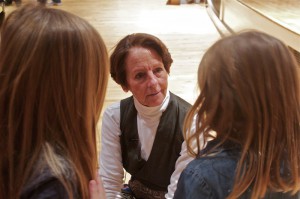How would you like to start your day off with a nice hot mug of yak butter tea? If you happen to travel to Nepal, you might have to get used to it.
On Friday, December 7, Marion resident and world traveler Sally Hunsdorfer gave a special presentation to the students at Sippican School about the country of Nepal and the service project she started to help its people.
Why Nepal? 15 years ago, she and her husband, Peter, dissolved two businesses they owned, pulled their teenaged sons out of school and the family backpacked around the world for a year.
“We wanted our sons to see what a beautiful and diverse place the world is, to get them to meet new people and see new things,” Hunsdorfer said.
Nepal, a country about the size of the state of Georgia nestled snuggly between the population powerhouses of India and China, was their favorite.
“We were immediately welcomed by the Sherpa culture,” she said.
The Sherpa are one of 85 tribes that inhabit Nepal. The group originated in China but migrated south over 500 years ago.
“We all became directly linked to the daily rhythms of their lives,” she said.
Hunsdorfer has returned to Nepal several times since the family’s first visit and usually resides there for three months out of the year.
During the assembly, Hunsdorfer explained how she started the Himalayan Project, a charity which began as a way to distribute warm clothes to needy Nepali families. She works with area schools which collect the clothes. Hunsdorfer then washes and organizes them all by hand at her Marion home and ultimately treks to some of the most remote villages of Nepal to pass them out to the people.
Local students also write letters to their Nepali peers, which Hunsdorfer delivers by hand because the country does not have a postal service. The students in Nepal learn English as part of their schooling, so they are able to read the letters they receive and directly respond.
She also detailed some of the cultural differences between Americans and the Nepali people. In a photo slideshow, she illustrated how boys and girls sit on opposite sides of the classroom and perform laborious daily chores around their homes. The nation has about an 80% illiteracy rate so the number of children who can afford to attend school, and make the four hour journey on foot to get there, is quite low.
“For a lot of kids around the world, education isn’t a birthright the way it is here in the United States. If you are born here, you are entitled to an education no matter who you are or where you live,” she told the students.
For more information on the Himalayan Project, visit himalayanproject.org.
By Eric Tripoli
